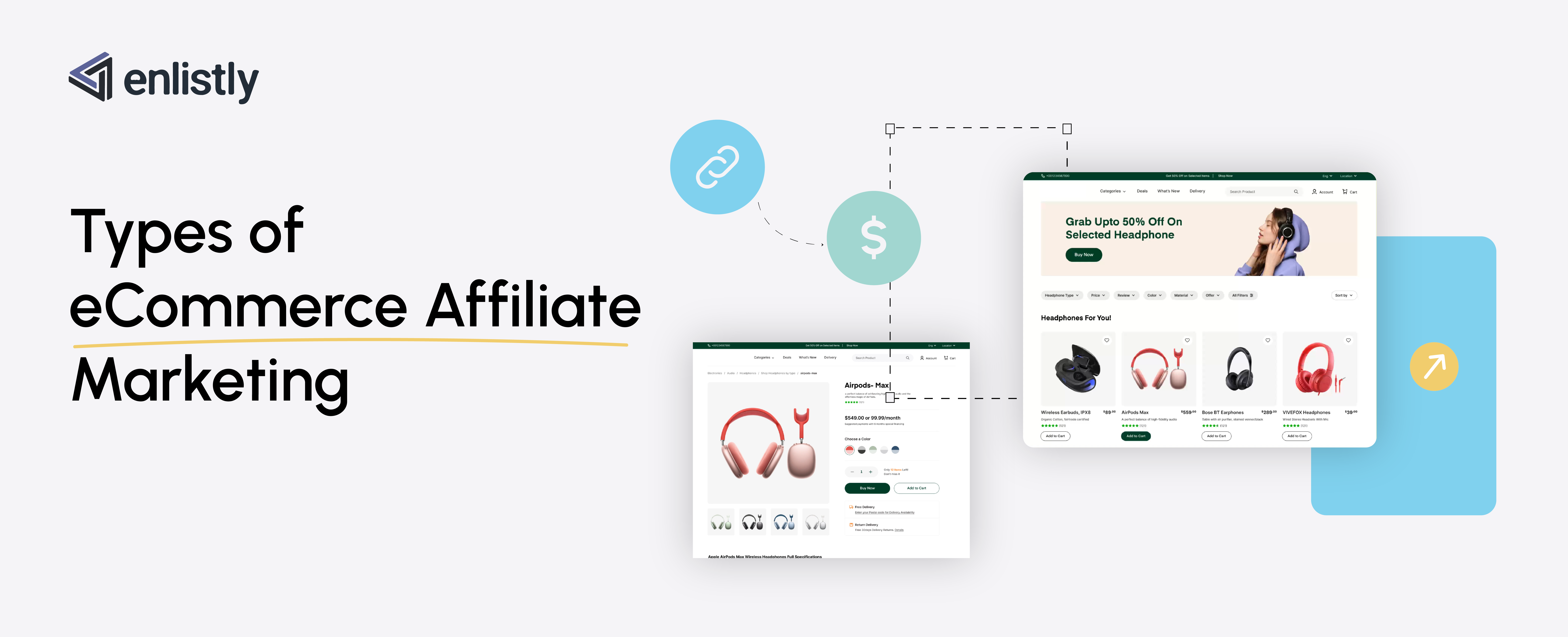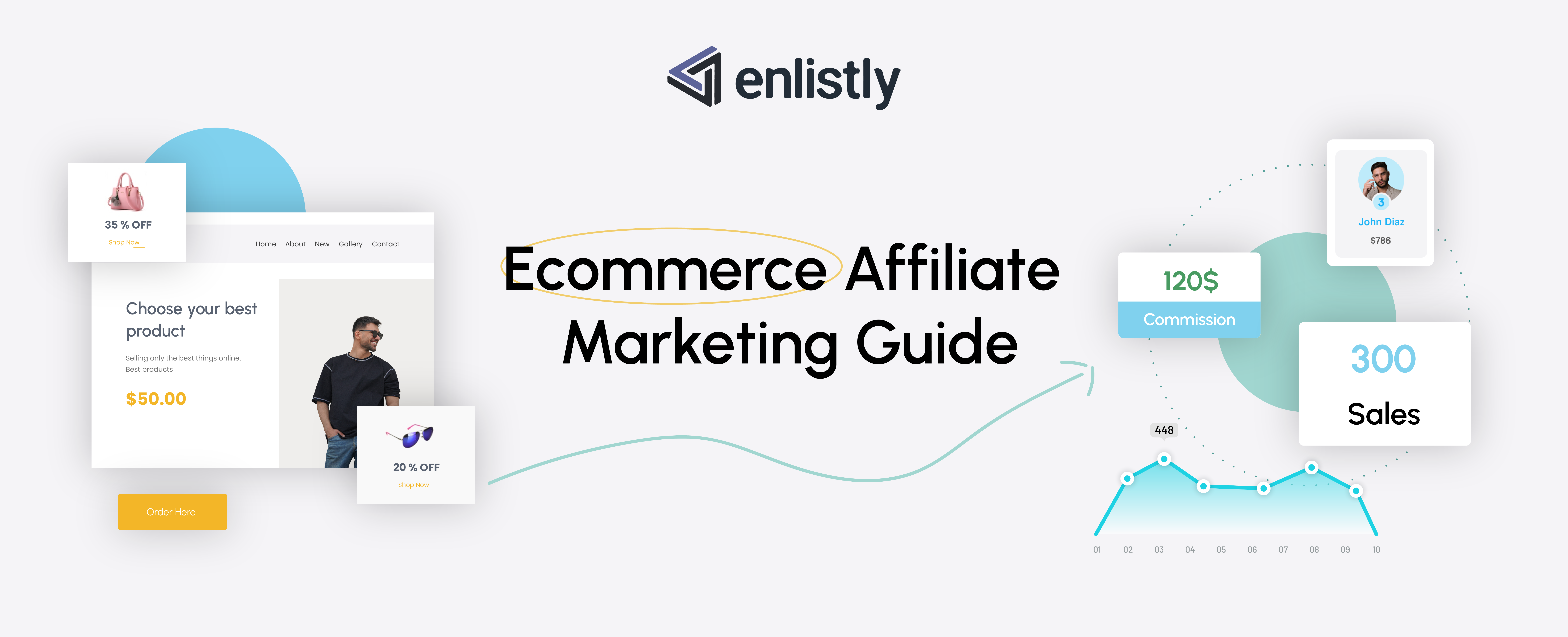Types of Affiliate Marketing for eCommerce Stores and What You Need to Know About Them

Learn about the different types of affiliate marketing for eCommerce businesses.
It has never been easy to drive traffic to your eCommerce store and convert them into customers. And with more retail businesses shifting online, things are only getting harder.
Amidst this chaos in the eCommerce space, affiliate marketing is one of the brightest sources of peace for online store owners. It allows eCommerce businesses to take their products to the right audience with low effort, low investments, and a guaranteed high return on investment.
It might sound too good to be true, but it’s just a derivative of highly targeted and automated marketing. It allows you to reach a wide audience, increasing brand awareness and growth.
In our previous blog post, we shared an in-depth guide to understanding eCommerce affiliate marketing. There we have all the basics of affiliate marketing, how it works, and how you can get started.
But before you get started, you must know the different types of affiliate marketing as well. It will help you select the right representative that suits your eCommerce business. Let’s jump right into it!
Types of Affiliate Marketing eCommerce Stores Can Explore
When you hear “affiliate marketing,” it’s mainly about affiliate websites and SEO with a link to send the audience to the eCommerce store. It might make you think that affiliate marketing has just one way to promote your product — via affiliate websites. But that’s not the case.
There are more types of affiliate marketing than you might realize. Have a look!
1. Content Sites
Content sites are one of the most popular choices of eCommerce brands for affiliate marketing. The affiliates who own these sites publish information about your store and what you sell. And somewhere in between, they give some product recommendations from your store to bring you sales and earn a commission.
Affiliates have to take care of everything from content to SEO in order to make the content reach the desired audience. All you have to do is find the content sites that publish content in your niche. There’s no point in reaching out to a sports content site when you’re selling beauty products on your online store.
If you get in touch with experienced affiliates, the content they write about your brand will rank high on the search engine. It will be beneficial for you in the long run as it’ll increase brand awareness and will keep the visitors coming to your store.
2. Review Sites
Review sites are a go-to place for potential customers to determine if a brand/product is worth their investment. According to an Inc report, 84% of customers trust online published reviews as much as their friends’ recommendations.
You can reach out to trustworthy review sites that publish reviews for the category of product that you sell. When review sites post honest reviews, their audience trusts them. And because of this trust, their audience will more likely convert into your customers.
Review affiliate marketing is not only beneficial because it’ll bring the affiliate’s audience to your store, but it will also save your customers from buyer’s remorse.
Let’s say you’re running a marketing campaign for some product, and a customer is unsure whether to go for the store/product. They can look up reviews on the internet, and the content published on these review sites will assist them in making a more informed purchase.
Now, you should avoid affiliate review sites that are being paid to post drastic reviews (negative or positive) about a brand. The audience knows that they’re being paid to do so. And because these sites are not trustworthy, the audience will have a hard time trusting you too.
3. Coupon Sites
The coupon site affiliates have a huge set of active audiences who visit the site frequently to find amazing deals on various products. When you tie up with such sites, you give them a custom promo code. Using this promo code, their audience gets a discount, and it also makes the sale trackable.
Coupon sites encourage their audience to sign-up for an email marketing newsletter, which allows them to deliver coupons of a specific category at a per-user level. This ensures that your coupon reaches the most relevant audience.
However, with coupon affiliate marketing, you can only promote products that have a high-profit margin because first you have to give a discount to the affiliate’s audience, and then you also have to give commission to the affiliates. So it doesn’t really work for an eCommerce store that sells products with low-profit margins.
Moreover, there are some arguments about coupon code affiliate sites that suggest that it doesn’t really bring new customers. YourYour existing customers might browse these coupon sites to find affiliate coupons and get a better deal.
4. Comparison Sites
What’s the first thing you do when looking for a good online deal? If you’re like 90% of the eCommerce buyers, you’ll go to the search engine and type a query — Best “product name” under “your budget.” In the results, you’ll find multiple comparison sites showing the same product from multiple online retailers with a detailed comparison.
This detailed comparison helps customers make better purchase decisions. They get to know which retailer is providing the product at a better price, whose quality of the product is better, etc.
You can contact these sites to feature your brand/product in their comparison site in return for some free samples and affiliate links. Sooner or later, the content they post for you will rank on the SERP, and traffic will start coming to your store.
The downside to this type of affiliate marketing is that the audience might as well go for the product offered by your competitors. So, while picking comparison sites, you must check if their content persuades buyers to go for a particular product without making it obvious.
5. Guides
Did you know that 71% of online customers use search engines to discover new products? And one of the most common results on the SERP, when they look for the product, is buying guides.
Buying guides are meant to help potential customers make an informed purchase by knowing the features, benefits, and usage of the product. These guides also have some recommendations which convince the reader to buy the product from a specific retailer.
This affiliate marketing strategy also uses SEO techniques to rank the guide higher on the SERP to get more traffic. Moreover, the buying guide sites publish niche-specific content to reach a more interested audience.
6. Social Media Influencers
There are a lot of individuals who gain popularity on social media platforms like Facebook, Instagram, TikTok, etc. A very particular set of audiences follows these influencers. Some create content in the fashion niche, and some are tech experts. Basically, for every category of eCommerce, there are influencers present.
And do you know how much people trust these influencers? Data from MuseFind that more than 90% of customers trust their favorite social media influencers more than traditional advertisements and celebrity endorsements. Over 37% of customers trust influencers more than the brands they are buying from.
Because of this level of trust, influencers can significantly increase traffic to your store and boost the conversion rate. In an influencer affiliate program, you can offer customer promo codes to these customers for their audience and give them some percentage of the profit.
You can get involved in how you want to show your products to their audience. This ensures that the influencers don’t promise something that you can’t deliver. Otherwise, your return rate will jump, and you’ll have to bear losses.
7. Loyalty Portal Affiliate Marketing
There are some companies that have a very large membership base. These companies advertise your offer on their website/app and give their customer some cashback when they purchase from you.
When the users buy using the loyalty portal’s affiliate link, these portals get a commission. And because these portals promise some cashback on the successful purchase, they have to give a share of their commission to the users.
The profit for loyalty portals per sale is comparatively lower than other affiliate types. But because of cashback and a large membership base, they are able to encourage more people to make a purchase.
Rakuten is one of the most popular loyalty portals that has paid over $2.2 billion to its users since 1999. The average cashback per user in 2020 was almost $65. It tells you how effectively these portals can bring sales for you.
8. PPC Affiliate Marketing
PPC affiliate marketing is quite different from content publishers. PPC affiliates don’t rely on heavy content to rank higher on the search result page because it takes time. This type of affiliate marketing generates immediate sales for your eCommerce business because the affiliates use paid advertising methods.
PPC affiliate marketing comes with high risk for the affiliates as they are paying for the ads, and there’s no guarantee that the ad viewers will perform the required action. However, experienced PPC affiliates use the ad targeting features (gender, age, interest, etc.) to target the set of audiences that are most likely to convert.
One disadvantage of PPC affiliate marketing is that if your affiliates are not working in conjunction with your current PPC strategies, they can increase the competition for your ads. For example, if both you and your PPC affiliate are trying to rank for the same keyword, only one of you two can rank higher.
Moreover, unlike the content affiliate strategy, it doesn’t have a long-term benefit. As soon as the affiliates stop funding the ad, the traffic stops coming.
Which Type of Program Should You Set Up for Your eCommerce Business?
Now that you know the different types of affiliate marketing, how do you select the one that’ll work the best for you? You can’t just select the one that has the maximum reach if it can’t help increase your conversion rate. For example, coupon sites and influencers give high reach, but businesses with low-profit margins can’t afford to give additional discounts.
Here are some points you should consider to select the best affiliate marketing program for your business.
Know Your Target Audience
Before you select your affiliate program, you need to know your target audience. At the end of the day, you want the affiliate content to reach your target audience. If you have clarity of who you want to reach, the affiliate program is not going to be much of a success.
To better know your target audience, you can run a survey with your existing customers. You can also use Google Analytics and Social Listening to know who is most likely to convert.
Identify What Influences Their Purchase Decisions
When you have identified your target audience, you need to look for metrics that influence them to make a purchase. What do they follow the most? Do they like reading product-related content on the internet? Are they spending their maximum time scrolling feeds on social media? You must have an answer to these questions.
For example, adults above the age of 30 like to read content on the web compared to teenagers who are quite active on social media. So for adults, an affiliate program that revolves around text-based content will be more influential. On the other hand, teenagers will be influenced by media-based content on social media, the type that influencers post.
Long story short, go for the affiliate programs that revolve around your potential customers’ online presence.
Ensure the Affiliate Program Suits Your Budget
Suppose, on a $100 product, you have a profit of $50. You decide to give a 10% commission to your affiliates. So, $10 goes to affiliates. But if you’ve gone for coupon sites or influencer affiliate marketing, you have to give an additional discount to the customers. Let’s keep it to 20%. Another $20 from your profits. You’re left with $20 only. That’s half of what you would’ve earned on your own.
If you consider loyalty portal programs with the commission, you’ll be given $10 to your affiliates, and that’s it. You keep $40 as a profit. And your affiliate loyalty portal will be responsible for giving a cashback to these customers.
Make a choice by keeping the profit ratio in your mind.
Set Up Your eCommerce Affiliate Program Today
There is no one type of affiliate marketing that works for every eCommerce business. Because every business comes with a distinct set of audiences, therefore, the program that best reaches them also differs.
You can evaluate all the types and then start with the one with maximum potential. However, it’s not compulsory to stick to just one type. But initially, it’s better to get hold of one before you jump onto another.
You must constantly monitor the result and do the needed optimization for the affiliate program to work smoothly.




1 Comment
[…] see their bottomline soar virally. In one of our last articles, we talked in depth about the different types of affiliate marketing plays available at a business’s disposal. So it’s only natural that we explore the one most […]
Comments are closed.